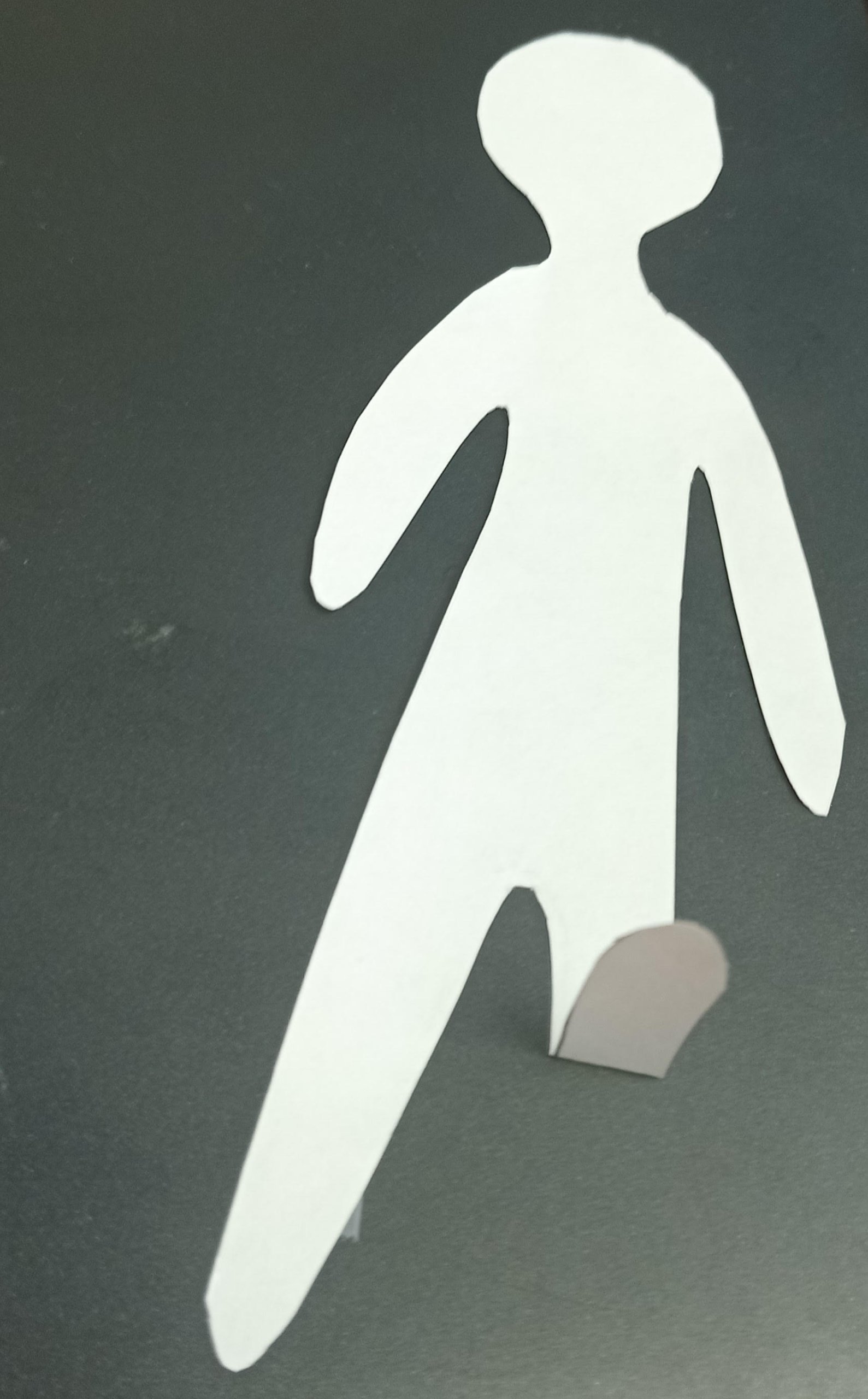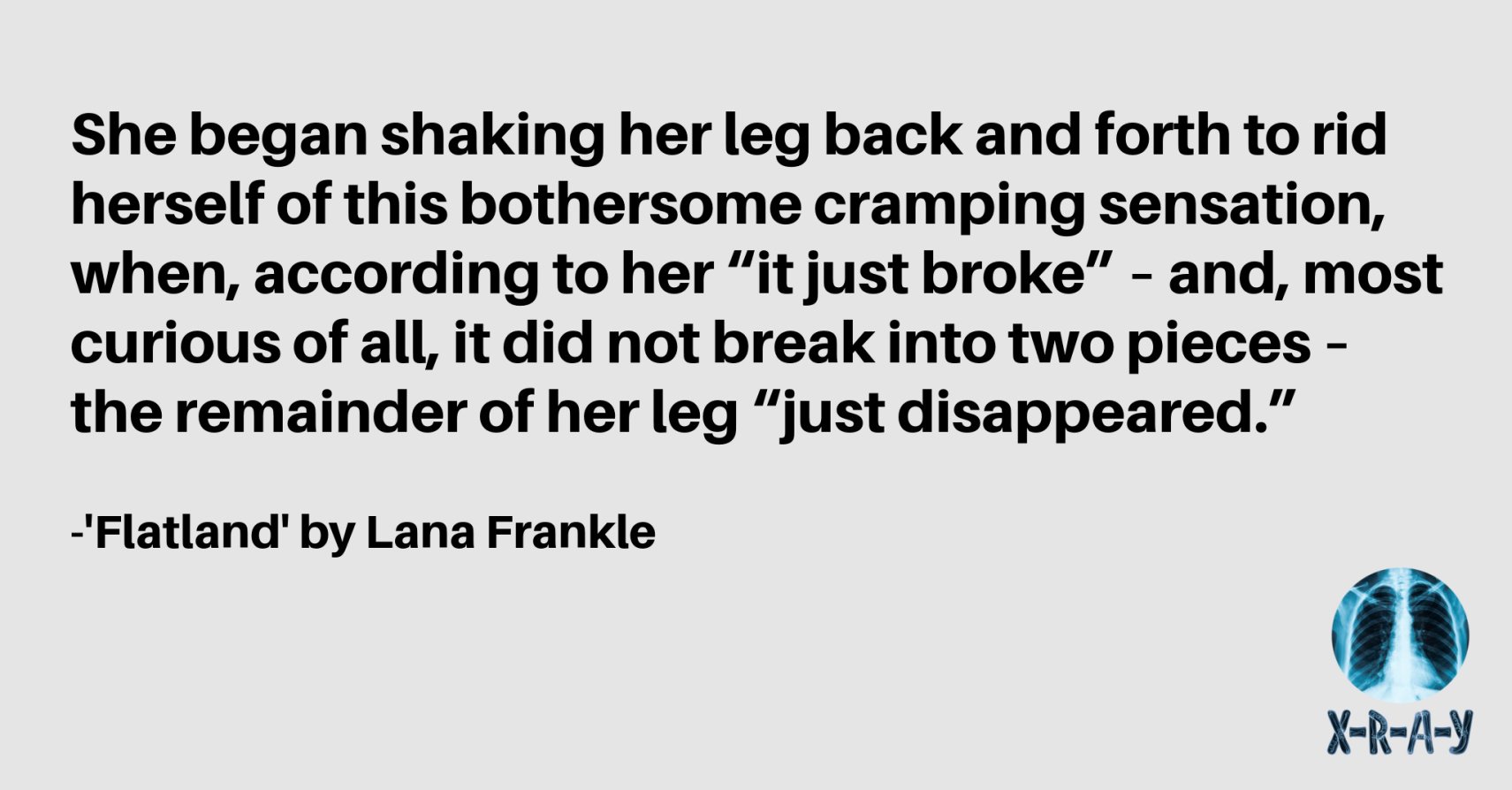A female patient of 29 years came to my care for what she described as “a strange break, an awful break” in her leg. After examining by palpitation I was able to verify that the lower portion of her left leg had indeed been severed, just below the knee joint. However, the contour of the juncture of this tear was quite unusual, namely, it was unusually smooth. Even breaks due to puncture by a sharp corner or line tend to leave some level of raggedness and unevenness. Upon noticing this, I asked her permission to make a proper documentation of her case for our most eminent medical journal, which she kindly acquiesced. The second thing that I noticed about her case was that, while her mobility was expectedly limited, and she did complain of pain, her vital signs were all within normal range, and physically she did not seem any the worse for having sustained this injury. As I continued to interview her, things became stranger still. When I asked her how she had sustained this injury, whether she had struck her leg on the sharp corner of a building or fixture, etc., she denied anything like this having happened, saying that she had been merely walking home when she started to feel a “strange throbbing” in her leg, as well as “icy chills” and “spasming.” She began shaking her leg back and forth to rid herself of this bothersome cramping sensation, when, according to her “it just broke” – and, most curious of all, it did not break into two pieces – the remainder of her leg “just disappeared.” While such an account is hardly credible, I duly noted her description, so that at least I would have documented what she herself had made of the situation, to aid me in determining what had actually taken place. I asked her if this had been the first time that she had experienced any of the described symptoms or cramping, and after a pause, she acknowledged that she had, on several prior occasions, experienced much the same thing, and had sought care from this the same medical office in the past, to no avail. “However,” she continued, “I did not think the symptom, as it was, was serious enough to require further assistance.” While broken legs have been known to occur, not infrequently, from accidental, unsteady movement or flailing, these breaks never involve severance of the limb, but rather contortion to the left or right, clearly absent in the patient before me.
When I asked her to describe the nature of her injury and pain, she insisted that she experienced “a dreadful phantom” of the leg. Phantom limb syndrome was known to her and myself, and the persistence of pain in a limb that has been so severed is itself not unusual. However, she did contradict herself, at times insisting that it “[was] no phantom, doctor, it’s still there, and it pains me so!” Being ever obliging of my suffering charges, I indulged her by asking what sort of pain she experienced. “It’s like nothing I can describe, doctor!” she exclaimed, a kind of unearthly thinness in her voice that gave even me some pause. “Do try,” I insisted. “It’s hot at the same time as it is cold, it shivers and sways back and forth as though caught in some terrible wind, even when there is no such wind. It bends back and forth even as I know it stays in place.” I calmly assured her that her leg was neither bending back and forth nor in place, it had been, by some means or other, removed, and she had naught to worry about anymore. But, ever the curious academic, I did press her on what she meant by “hot and cold at the same time.” She then paused for so long I was not sure she had heard me or would answer. “It’s as though half of it is hot and half of it is cold.” she finally said, haltingly. In relation to everything else she had described thus far, this did not seem so strange an answer as to warrant such hesitation and drama, so I wondered if I were not still missing some crucial component of her experience, due to her inability to describe it or mine to understand it. Ever cautiously, I asked her, “Which half do you mean? Is the top half cold and the bottom half hot? Or is the right side cold and the left side hot? Or vice versa.”
“It isn’t like that, doctor,” she said, and I could read easily the consternation in her voice. Even more cautiously than I had asked, she answered slowly, “The top side is hot, and the bottom side is cold.” “Yes,” I said, growing impatient. So, just below the knee-” “No, doctor,” she cut me off abruptly and then sighed in frustration. “It is the top, where the knee ends, yes, but just one side.” “Yes,” I replied evenly. “So, is it the right? The left?” but, rather than answer, she chose to avoid the question, and continued by adding that it was as though the missing, phantom leg, were “swaying back and forth in some breeze – only it isn’t back and forth. It’s more like – up and down.” This description made no more sense than anything else, but I duly added it to my written notes. Before sending her on her way, I offered her a prescription for pain killers, as was my duty as a physician. She accepted them, and then, pausing one final time, urged me to palpate the wound again, paying particular attention to “the sides of it, the corner, the…bend.” I reminded her that there was no such bend, as her leg had not been broken sideways in a way that could be realigned, but had been severed, and furthermore that the missing piece had been lost and could thus never hope to be reattached. “But, it’s right there doctor!” she exclaimed. “It is bent…just up.”
No longer paying her words much mind, I moved towards her to palpate the damaged limb a final time, feeling my fingers round the perfect line of the break, where instead of a ravaged, jagged tear, there was only that same smoothness that had first so caught my interest.


